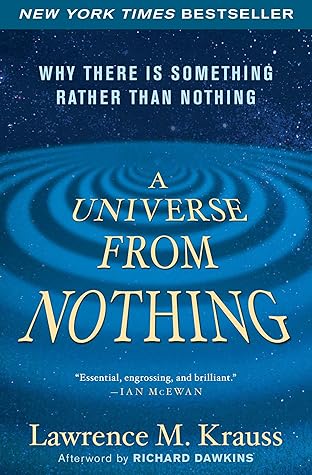More on this book
Community
Kindle Notes & Highlights
As a result, you might presume to safely argue that this “something” that is produced by quantum fluctuations is ephemeral—not measurable, unlike, say, you or I or the Earth on which we live. But this ephemeral creation, too, is subject to the circumstances associated with our measurements.
However, the quantum theory of electromagnetism suggests that the static field is due to the emission, by the charged particles involved in producing the field, of virtual photons that have essentially zero total energy. These virtual particles, because they have zero energy, can propagate across the universe without disappearing, and the field due to the superposition of many of them is so real it can be felt.
Scientists began to understand in the 1970s, however, that it is possible to begin with equal amounts of matter and antimatter in an early hot, dense Big Bang, and for plausible quantum processes to “create something from nothing” by establishing a small asymmetry, with a slight excess of matter over antimatter in the early universe.
Even if the asymmetry were 1 part in a billion there would be enough matter left over to account for everything we see in the universe today. In fact, an asymmetry of 1 part in a billion or so is precisely what was called for, because today there are roughly 1 billion photons in the cosmic microwave background for every proton in the universe.
question of why there is something rather than nothing: nothing is unstable.
As I have defined it thus far, the relevant “nothing” from which our observed “something” arises is “empty space.” However, once we allow for the merging of quantum mechanics and general relativity, we can extend this argument to the case where space itself is forced into existence.
General relativity as a theory of gravity is, at its heart, a theory of space and time. As I described in the very beginning of this book, this means that it was the first theory that could address the dynamics not merely of objects moving through space, but also
how space itself evolves. Having a quantum theory of gravity would therefore mean that the rules of quantum mechanics would apply to the properties of space and not just to the properties of objects ex...
This highlight has been truncated due to consecutive passage length restrictions.
Feynman developed, which led to a modern understanding of the origin of antiparticles, is well suited to the task.
In order to explore this, Feynman developed a “sum over paths formalism” to make predictions. In this method, we consider all possible trajectories between two points that a particle might take. We then assign a probability weighting for each trajectory, based on well-defined principles of quantum mechanics, and then perform a sum over all paths in order to determine final (probabilistic) predictions for the motion of particles.
Remember that, in the quantum theory of electromagnetism, particles can pop out of empty space at will as long as they disappear again on a time frame determined by
the Uncertainty Principle. By analogy, then, in the Feynman quantum sum over possible space-time configurations, should one consider the possibility of small, possibly compact spaces that themselves pop in and out of existence?
1. In quantum gravity, universes can, and indeed always will, spontaneously appear from nothing. Such universes need not be empty, but can have matter and radiation in them, as long as the total energy, including the negative energy associated with gravity, is zero. 2. In order for the closed universes that might be created through such mechanisms to last for longer than infinitesimal times, something like inflation is necessary. As a result, the only long-lived universe one might expect to live in as a result of such a scenario is one that today appears flat, just as the universe in which we
...more
The lesson is clear: quantum gravity not only appears to allow universes to be created from nothing—meaning, in this case, I emphasize, the absence of space and time—it may require them. “Nothing”—in this case no space, no time, no anything!—is unstable.
The central problem with the notion of creation is that it appears to require some externality, something outside of the system itself, to preexist, in order to create the conditions necessary for the system to come into being.


